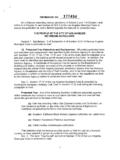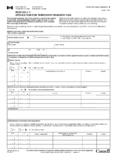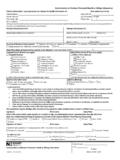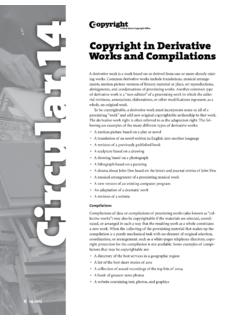Transcription of Marine protected areas: Interactions with fisheries ...
1 FAO. ISSN 2070-7010. fisheries AND. AQUACULTURE. TECHNICAL. PAPER. 603. Marine protected areas: Interactions with fishery livelihoods and food security Cover photo credits: First row, left to right: Local fishers about to land in the afternoon after fishing in Karimunjawa, Indonesia (Laely Nurhidayah); Women selling fishing in Chennai, India (Anthony Charles); Jetty with traditional boats in Kalitoko village in Mayalibit Bay, Indonesia (Laely Nurhidayah); A typical commercial net fishing operation within the Great Barrier Reef, Australia (Anon). Second row, left to right: Artisanal fishers, Costa Rica (Andrew B. Bystrom); Fishing on foot, Mauritania (Djibril Ly);. Local fishers in Madagascar (Ambroise Brenier/WCS); A young woman propelling a Bajau Laut houseboat between Selakan and Maiga islands in a General Use Zone of Tun Sakaran Marine Park, Malaysia (Greg Acciaioli); Young girls from Sampela village, Wakatobi, Indonesia gleaning the reef flats at dusk, collecting sea cucumber and various molluscs (Dirk Steenbergen).
2 Third row, left to right: Bajau families trading the day's catch, Sampela village, Wakatobi, Indonesia (Julian Clifton);. local community activities in Go village, Indonesia (Laely Nurhidayah). Bottom row, left to right: A Bajau Laut water village off shore of Bodgaya Island, Tun Sakaran Marine Park, Malaysia (Natasha Stacey); Joe Fuller, trap and line fisher Minnie Water, NSW, Australia (Ron Fuller);. Bajau Bringing seaweed to Sebangkat Island in Tun Sakaran Marine Park, Malaysia for sale to a Chinese intermediate marketer (Greg Acciaioli); Soariake Marine protected area , Madagascar (Ambroise Brenier). Marine protected areas: FAO. fisheries AND. AQUACULTURE. Interactions with fishery TECHNICAL. PAPER. livelihoods and food security 603. Edited by Lena Westlund FAO Consultant FAO fisheries and Aquaculture Department Rome, Italy Anthony Charles School of the Environment and School of Business Saint Mary's University Halifax, Canada fisheries Expert Group IUCN Commission on Ecosystem Management Serge M.
3 Garcia fisheries Expert Group IUCN Commission on Ecosystem Management Fiumicino, Italy Jessica Sanders fisheries Officer FAO fisheries and Aquaculture Department Rome, Italy Published by the Food and Agriculture Organization of the United Nations and International Union for Conservation of Nature Rome, 2017. The designations employed and the presentation of material in this information product do not imply the expression of any opinion whatsoever on the part of the Food and Agriculture Organization of the United Nations (FAO), or of the International Union for Conservation of Nature (IUCN) concerning the legal or development status of any country, territory, city or area or of its authorities, or concerning the delimitation of its frontiers or boundaries. The mention of specific companies or products of manufacturers, whether or not these have been patented, does not imply that these have been endorsed or recommended by FAO, or IUCN in preference to others of a similar nature that are not mentioned.
4 The views expressed in this information product are those of the author(s) and do not necessarily reflect the views or policies of FAO, or IUCN. ISBN 978-92-5-109606-2. FAO, 2017. FAO encourages the use, reproduction and dissemination of material in this information product. Except where otherwise indicated, material may be copied, downloaded and printed for private study, research and teaching purposes, or for use in non-commercial products or services, provided that appropriate acknowledgement of FAO as the source and copyright holder is given and that FAO's endorsement of users' views, products or services is not implied in any way. All requests for translation and adaptation rights, and for resale and other commercial use rights should be made via or addressed to FAO information products are available on the FAO website ( ). and can be purchased through iii Preparation of this document This document on Marine protected areas: Interactions with fishery livelihoods and food security has been prepared jointly by the FAO fisheries and Aquaculture Department and the IUCN fisheries Expert Group (FEG).
5 It builds on work presented at the IUCN. World Parks Congress (WPC) held in Sydney, Australia, on 12 19 November 2014, and contains a total of twelve papers (see list of contributors). The papers have been technically edited by Lena Westlund, Anthony Charles, Serge Garcia and Jessica Sanders. FAO would like to extend its appreciation to all authors for their contributions both at the WCP and to this document. We are grateful to Linda Mitchell for editing the text, to Enzo Luchetti for the desktop publishing layout and to Gilles Kaboha for the translation from French of the paper on Mauritania. Anthony Charles acknowledges support from the Social Sciences and Humanities Research Council of Canada, through the Community Conservation Research Network ( ). FAO gratefully acknowledges the financial support from the Government of Japan to FAO participation at the WPC and to the publishing of this document through the project Improved fisheries management for sustainable use of Marine living resources in the face of changing systems (GCP/.)
6 INT/228/JPN) . iv Abstract Building on work presented at the IUCN World Parks Congress (WPC) held in Sydney, Australia, on 12 19 November 2014, this document explores experiences with aquatic protected areas (PAs), Marine protected areas (MPAs) and protected areas in inland waters in the context of livelihoods and food security. It includes: (i) ten papers reporting on the interface of MPA/ protected areas with livelihoods and food security, based on case studies in Africa, Asia, Latin America and Oceania; (ii) an eleventh contribution providing a more general overview of MPAs and food security and how to assess their impact; and (iii) a final paper synthesizing the conclusions of the papers and discussing the observed outcomes of aquatic PAs, together with problems and solutions. The document's contributions recognize that the assessment of impacts of aquatic PAs on fisheries livelihoods and food security meets with difficulties related to: the newness of the issue in the context of aquatic PAs; compounding effects of external drivers; monitoring costs; lack of empirical evidence and deficient experimental designs.
7 And lack of systematic ex ante and ex post assessments. Nevertheless, it is possible to identify certain key problem areas, associated with the distribution of costs and benefits, the high degree of dependence of fishing communities, the highly dynamic patterns of evolution of the general context of both the fisheries and the aquatic PAs concerned, the difficulty and cost of enforcement, and commonly recurrent financing difficulties. The positive outcomes observed in the case studies presented here relate to improved social cohesion and participation, conservation and incomes, but concerns are also expressed about a lack of attainment of expected outcomes. It is stressed that no generalization on the efficacy of aquatic PAs in supporting livelihoods is possible. Direct measures of impact on food security and poverty are not available. Numerous elements to address the problem are proposed relating to: (i) dedicated policies; (ii) clearer and more comprehensive objectives; (iii) community participation; (iv) communication between stakeholders; (v) building capacity to collaborate effectively; (vi) incorporating a mix of technical and structural measures; (vii) use of traditional knowledge; (viii) systematic recording of empirical evidence; and (ix) compensation, alternative livelihoods and income-generating activities.
8 The contributed papers are reproduced as submitted. Westlund, L.; Charles, A.; Garcia S.; Sanders, J. (eds). 2017. Marine protected areas: Interactions with fishery livelihoods and food security. FAO fisheries and Aquaculture Technical Paper No. 603. Rome, FAO. v Contents Preparation of this document iii Abstract iv Contributors vii Abbreviations and acronyms ix Introduction 1. MPAs and fisheries in the context of food security and sustainable livelihoods in Indonesia: Case study of MPAs in Karimunjawa and Mayalibit Papua, Indonesia 5. Laely Nurhidayah and Shawkat Alam Analysis of small-scale fishery development within Costa Rica's MPA. system 21. Andrew B. Bystrom Establishing freshwater protected areas to protect biodiversity and improve food security in the Philippines 31. Jan van der Ploeg, Lien Vermeersch, Dominic Rodriguez, Marites Balbas and Merlijn van Weerd Fishers and Conservation: sharing the case study of Hinase, Japan 43. Izumi Tsurita, Masakazu Hori and Mitsutaku Makino Changes in fisheries production following large scale expansion of no-take closures within the Great Barrier Reef, Australia: the results, the debate and implications for policies related to food security 51.
9 Warrick J. Fletcher Alternative Solutions for a traditional society undergoing change: support for adding value to Imraguen fishery products from Banc d'Arguin National Park, Mauritania 57. Djibril Ly The positive relationship between the Ostional community and the conservation of olive ridley sea turtles at Ostional National Wildlife Refuge, Costa Rica 69. Carlos Mario Orrego and Norma Rodr guez Integrating conservation and development in Madagascar's Marine protected areas 85. Ambroise Brenier and Aur lie Vogel The fishermen do it tough, you know': Oral histories highlight varied impacts on commercial fishers' livelihoods with the introduction of the Solitary Islands Marine Park, Australia 99. Nicola Johnstone, Hamish Malcolm, Arianne Reis, Philip Hayward and Jo Kijas Impacts of Marine protected Areas on Livelihoods and Food Security of the Bajau as an Indigenous Migratory People in Maritime Southeast Asia 113. Natasha Stacey, Greg Acciaioli, Julian Clifton and Dirk J. Steenbergen vi Marine reserves and food security: why we failed so far to build robust evidence 127.
10 Christophe B n . Interactions of Marine protected areas with fishery livelihoods and food security: concluding discussion 151. Serge M. Garcia, Anthony Charles, Jessica Sanders and Lena Westlund vii Contributors Greg ACCIAIOLI. University of Western Australia, Perth, Australia Shawkat ALAM. Macquarie Law School and Director, Centre for Environmental Law Macquarie University, Sydney, Australia Marites BALBAS. Mabuwaya Foundation, Philippines Christophe B N . International Center for Tropical Agriculture (CIAT), Colombia Ambroise BRENIER. Wildlife Conservation Society, Bronx, New York, United States of America Andrew B. BYSTROM. Unidad de Investigaci n Pesquera y Acuicultura (UNIP) of the Centro de Investigaci n en Ciencias del Mar y Limnolog a (CIMAR), Universidad de Costa Rica, San Jos , Costa Rica; Programa Restauraci n de Tortugas Marinas (PRETOMA). Anthony CHARLES. School of the Environment and School of Business, Saint Mary's University, Halifax, Canada, & fisheries Expert Group, IUCN Commission on Ecosystem Management Julian CLIFTON.
















